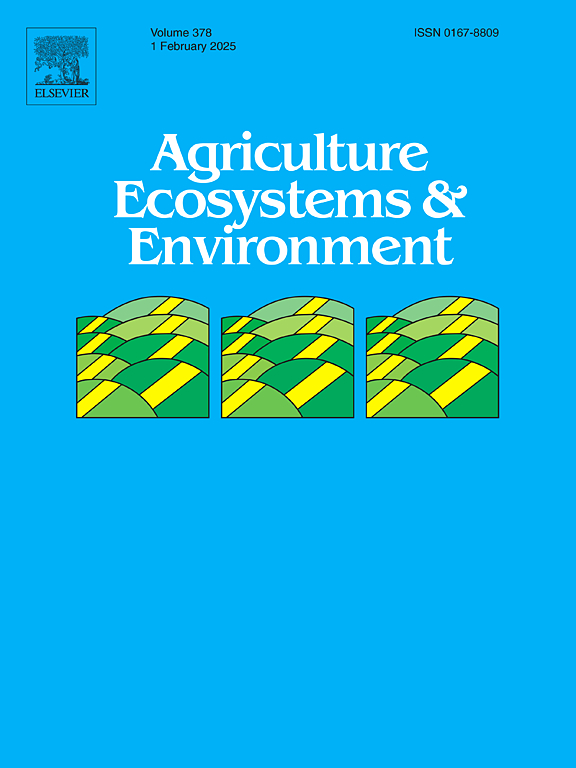Complementary effects of encroachment and grazing intensity for soil quality in a mountain grassland
IF 6
1区 农林科学
Q1 AGRICULTURE, MULTIDISCIPLINARY
引用次数: 0
Abstract
Grasslands are globally significant ecosystems held in an ecological balance by herbivory, with a natural tendency towards shrub encroachment, creating a tension between two alternative successional trajectories. The influence of grazing pressure on soil properties is not yet accurately predicted across ecosystems, nor its interaction with encroachment, with quite variable effects found. We studied the combined effect of grazing and encroachment on soil ecophysiological processes by collecting soil samples from paired locations with and without shrub presence across a managed high-altitude pastureland of 14,000 ha. By tracking 26 sheep herds with GPS collars over multiple years, we created a spatially explicit map of grazing intensity over the landscape, permitting quantification of grazing impacts on soil properties on a continuous scale. Grazing changed soil nutrient status, increasing total soil nitrogen (TN) by up to 0.77 % over the gradient, and available phosphorus (Pavail) by up to 12 times. Grazing increased soil organic carbon (SOC) content by up to 4.5 % across the gradient, and encroachment increased SOC by 1.2 %. SOC increases under these two conditions likely represent two co-occurring paths soil carbon accumulation since particulate organic carbon (POC) was increased by 44 % under shrubs, while the effect of grazing was unclear. Grazing and encroachment impacts on the soil microbial community diverged, since microbial biomass carbon (Cmic) increased by up to 86 % with grazing intensity with a simultaneous decrease in microbial basal respiration and metabolic quotient (qCO2), however neither were affected by encroachment. Overall, encroachment and grazing were seen to be complementary for soil protection and provision of ecosystem services, though their effects on certain parameters were contrasting. This knowledge may be useful for adaptive management in high nature value agroecological landscapes, and can improve large-scale projections of SOC stocks and other soil properties incorporating varying degrees of grazing intensity and the influence of encroachment.
侵蚀与放牧强度对山地草地土壤质量的互补效应
草原是全球重要的生态系统,由草食维持生态平衡,具有灌木侵蚀的自然趋势,在两种替代演替轨迹之间产生紧张关系。放牧压力对整个生态系统土壤性质的影响尚未得到准确预测,其与侵蚀的相互作用也尚未得到准确预测,结果发现影响变化很大。通过在14000 ha的高海拔草地上采集有灌木和没有灌木的成对地点的土壤样本,研究了放牧和入侵对土壤生态生理过程的综合影响。通过使用GPS项圈对26个羊群进行多年跟踪,我们创建了一个明确的放牧强度空间地图,允许在连续尺度上量化放牧对土壤特性的影响。放牧改变了土壤养分状况,土壤全氮(TN)在坡度上增加了0.77 %,有效磷(Pavail)增加了12倍。放牧使土壤有机碳(SOC)含量增加了4.5 %,侵蚀使土壤有机碳含量增加了1.2 %。土壤有机碳(POC)在灌丛条件下增加了44. %,而放牧对土壤碳积累的影响尚不清楚。放牧和入侵对土壤微生物群落的影响存在差异,随着放牧强度的增加,微生物生物量碳(Cmic)增加高达86% %,微生物基础呼吸和代谢商(qCO2)同时减少,但两者均不受入侵的影响。总体而言,侵占和放牧在土壤保护和提供生态系统服务方面是互补的,尽管它们对某些参数的影响存在差异。这些知识可能对高自然价值农业生态景观的适应性管理有用,并可以改善大规模预测有机碳储量和其他土壤性质,包括不同程度的放牧强度和侵占的影响。
本文章由计算机程序翻译,如有差异,请以英文原文为准。
求助全文
约1分钟内获得全文
求助全文
来源期刊

Agriculture, Ecosystems & Environment
环境科学-环境科学
CiteScore
11.70
自引率
9.10%
发文量
392
审稿时长
26 days
期刊介绍:
Agriculture, Ecosystems and Environment publishes scientific articles dealing with the interface between agroecosystems and the natural environment, specifically how agriculture influences the environment and how changes in that environment impact agroecosystems. Preference is given to papers from experimental and observational research at the field, system or landscape level, from studies that enhance our understanding of processes using data-based biophysical modelling, and papers that bridge scientific disciplines and integrate knowledge. All papers should be placed in an international or wide comparative context.
 求助内容:
求助内容: 应助结果提醒方式:
应助结果提醒方式:


